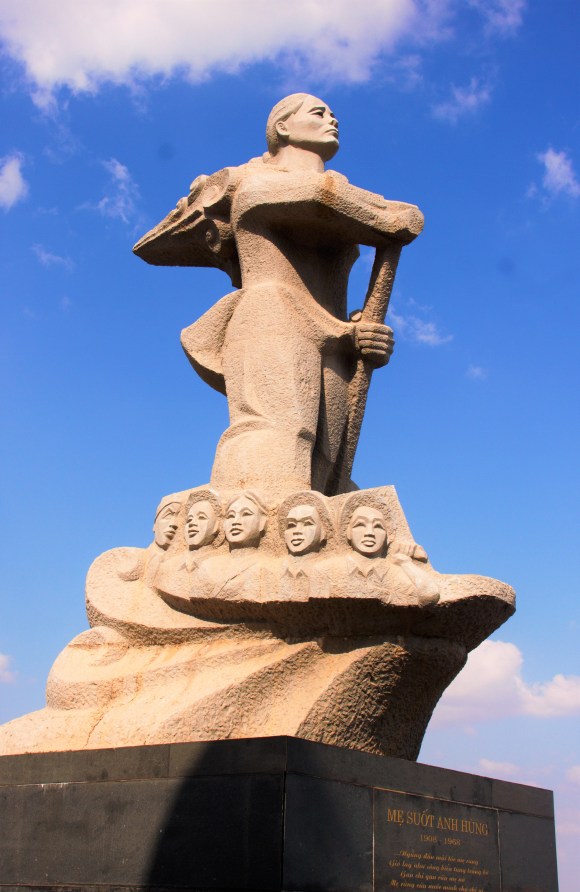Xin Chào from Việt Nam,
When certain elements of a society clamour for the removal of certain statues, it’s all about the actions and ideologies of the individual. And how those actions might appear to be anachronistic or hurtful in a modern context. Leopold II in Belgium is spattered with bloody red paint. Robert E. Lee is brought down in a park in America. Even James Cook is seen as problematic in New South Wales.
Perhaps the answer is to avoid human statues altogether. Or to have national heroes such as Kemal Ataturk depicted in groups. What about commemorating unsung heroes, as they tend to do here in Việt Nam? These are the people whose “contributions were sometimes very silent”, says one interpretation sign at the Southern Việtnamese Women’s Museum in Hồ Chí Minh City, which matches the National Women’s Museum in Ha Noi.





The massive statue of Nguyễn Thị Thu in Tam Kỳ is a magnificent monument to a woman with an uncommon story. No-one will ever want to tear it down.

heroic mothers
Nguyễn Thị Thu is one of 19000 Vietnamese women who have been honoured – sometimes posthumously – as Heroic Mothers. In her case, she lost 11 sons and grandchildren in the war. Although her nine sons never came home, and whose remains have never been located, Nguyễn Thị Thu survived them all and died at the age of 106. This is what is described in the Southern Women’s Museum as “losses suffered . . . the most incurable wounds in hearts”.
the long hair army
There are many other mothers modestly remembered in the same museum. For instance, Trần Thị Viết also lost multiple descendants in the long war. She was enrolled in the militia and helped to dig the Củ Chi tunnels. Many others were directly involved in the “long hair army” but many were busy in civil service as well.
These are women who have endured “many dedications and sacrifices to the cause of liberation and defence” of the nation. Interpretive signs quoting Hồ Chí Minh himself described them as “heroic, undaunted, loyal and responsible”. One of the reasons for Việt Nam’s military success was the active and fearless participation of women in many roles. The saying goes, “when enemies attack the home, women fight”.
Women’s Museum – Ho Chi Minh City
The Southern Việtnamese Women’s Museum, found in a street named after Võ Thị Sáu (herself a national hero), contains stories of bravery and stoicism. And the magnificent monument to Nguyễn Thị Thu, in the township of Tam Kỳ, is fitting commemoration of the sacrifice of a heroic mother who never left central Việt Nam in her long life. The statue is 18.6 metres high and 120 metres wide, made of granite. Designer Đinh Gia Thắng said the flowing mane of the monument represents an enormous stream of the national soul. He wants it to symbolise mothers delivering brave children who become Việt Nam’s mountains and water.
Can you ever imagine a circumstance in which anyone wants to tear it down? In the words of the museum’s curator, “They deserve to be glorified in honours lasting forever, as precious lessons for future generations”.
Hẹn gặp lại from Việt Nam,
Greg
Other photos on the theme



4 replies on “dedications and sacrifices”
Hi Greg
I found this article really interesting, especially with your point of view about the removal of statues due to the conflict between ideologies, such as King Leopold II in Belgium or Robert E. Lee in the US. Even Vladimir Lenin monuments were taken down in countries like Ukraine, which clearly shows that there are values such as ideologies that do not last forever.
However, there are still values that remain alongside the changes of life: love, friendship, family, and sacrifices for the right things, such as to protect the home country from outsiders.
I appreciate the values behind the statues of Vietnamese heroic mothers like Nguyen Thi Thu or Tran Thi Viet, as they sacrificed their own family and happiness for the independence of Vietnam, and they deserve to be remembered. However, there are thousands of other mothers like them whose “contributions were sometimes very silent”, that we can never build enough statues and monuments for each and every one of them.
Should we build more statues? Yes if we want to. Are they necessary? Maybe not.
Because they are and will always be remembered, in stories, folks, films and so on. Most importantly, they will always be in the mind and spirit of future Vietnamese generations, because they fought for the right things, and gave everything they got, as you said in the title, “dedications and sacrifices”.
Thanks for your thoughtful comment, Cuong. Perhaps we could take the statues to symbolise other efforts and sacrifices, too rather than that of the single entity being commemorated. I think that might be the best way to perceive them. This is especially possible in Viet Nam, where a collective culture is prevalent. In such a culture, it’s counter-intuitive to laud an individual over others. Every time I look at an individual’s story, I wonder how many others had similar stories. That must be particularly true in Viet Nam.
I am really impressed with this post of you, I can see a deep knowledge as well as a respectful for Vietnamese in spite of a foreigner.
Thanks, Chi. I hope other Vietnamese readers also see respect in the words. I have tried valiantly to spell all of the names correctly with accents where needed. Please let me know if any are faulty.